Content
- 1 The best conditions for carrots
- 2 Sowing process
- 3 Sowing and sprouting
- 4 Carrot care
- 5 What to consider when planting carrots in open ground with seeds
- 6 Soil preparation
- 7 Planting carrots by seeds in open ground
- 8 Outdoor carrot care and proper watering of carrot beds
- 9 Disease and pest control
- 10 Crop rotation
- 11 Preparing the soil for carrot beds
- 12 Fertilizers for carrots
- 13 Sowing carrots
- 14 Planting care
- 15 Harvesting
Carrots are in second place after potatoes in the popularity rating of root crops grown in our summer cottages. And the most demanding root crop for growing conditions and care, although this is not obvious. Especially novice gardeners complain that the carrots have not been born, or that the carrots are small, crooked, "hairy", cracking, bitter, with black dots, rotting and moldy during storage. A lot of troubles can happen to carrots during their growth. To avoid them, you need to strictly observe the agricultural technology of carrots.
Growing and caring for carrots
The best conditions for carrots
This is an open field plant. There is no need to grow carrots by seedlings in our latitudes. The first of the specific conditions for carrots is soil.
The quality of the soil for carrots is very important.
Soil for carrots
It should be loose. Most often in our gardens, heavy soil.
And carrots need:
- loam or sandy loam;
- increased fertility;
- well aerated;
- with an additional baking powder (sand);
- with acidity as close to neutral as possible (pH 6-7);
- moisture-consuming;
- does not form a soil crust.
Soil for carrots - we prepare quality soil
It is advisable to observe these conditions not separately, but all at once. They are all important, but the most important thing is, perhaps, the looseness of the soil. Oxygen must be supplied to the root crop, otherwise it will have low taste and suffer from fungal diseases.
Important! When sowing seeds in insufficiently loose and moisture-absorbing soil, their germination is greatly reduced.
The predecessors are suitable and not very
The second important factor. The plant cannot be grown in one place even for two years in a row. Carrots are not suitable for monocultures, since already in the second year of cultivation in the old place, they begin to be affected by aphids, nematodes, Alternaria and especially carrot flies.
Good carrots cannot be grown without adherence to agricultural technology.
The place of cultivation of the root crop must be changed annually. To return to the old one - not earlier than in the fourth year.
Precursors of carrots
| Cabbage | Carrot |
| Luke | Caraway |
| Tomatoes | Parsley |
| Legumes | Dill |
| Cucumbers | Parsnip |
Crop rotation
Sowing process
The timing of sowing carrot seeds in open ground depends on several factors. They are:
- weather;
- varietal features;
- the purpose of growing.
Before sowing, the seeds must be prepared, and the soil must be treated and fertilized.
Soil preparation
Before sowing a root crop in the garden, nutrients must be added there. For carrots, the presence of humus or compost is mandatory during the period of germination and the beginning of development. Per square meter of the ridge, the norm of humus or vegetable compost is 5 liters.
You need to add compost to the soil
Plus, nitrogen-potassium-phosphorus fertilizers are introduced to organic matter.Digging the soil to the floor with a shovel bayonet is carried out two weeks before sowing.
Nitrogen-phosphorus potash fertilizers
If your soil is heavy loam, add sand as a baking powder, sawdust and ash. The root vegetables will be sweet, juicy, even and well stored.
Ash as fertilizer and baking powder
Important! Fresh manure cannot be applied under carrots (even if sowing is carried out before winter). The introduction of unripe organic matter will necessarily lead to branching of root crops and a significant deterioration in taste. It is also not necessary to apply more nitrogen fertilizers than the norm, otherwise the tissues of the root crop will coarsen, the juiciness will decrease, but an excess of nitrates will appear.
On the eve of sowing, the land on the ridge is loosened, leveled, watered. Grooves of two centimeters deep are made in the ground, with a distance of 15 cm between them.
In the photo there are beds with grooves
Seed preparation
One of the ways to sow carrots is winter sowing. In this case, the seeds are not processed in any way and do not undergo preparation. Sown dry.
Planting carrots
During the winter in the ground, they go through the process of vernalization, and in the spring they start growing very early. Since seeds germinate already at + 8 ° C, ready-made root crops of winter sowing can be obtained two weeks earlier than those sown in spring. But such root vegetables of carrots are not suitable for long-term storage.
Seedlings of carrots
Advice! In spring, early carrots are sown in early April, late ones - from mid-April to early May. The earlier you sow carrots, the more moisture stored in the soil from winter will get to the seeds.
Carrots take a long time to germinate - some varieties may take up to 25 days. This process is designed to speed up the preparation of seeds, as well as to disinfect them in order to protect them from future diseases.
Methods for preparing carrot seeds
|
Soaking in salt and hot water |
First, the seeds are placed in a jar of saline water solution (2 tablespoons / 1 L). Those that come up are not worth sowing - these are dummies that do not contain an embryo. The settled seeds are removed from the water, washed and dipped, wrapped in a cloth, in hot (+ 60 ° C) clean water for a quarter of an hour. Rinse again with cool water. It is dried during the day and sown. |
|
Cold disinfection (cold stratification) |
This method is the easiest one. There is no need to prepare solutions, long soaking is also not required. After placing the seeds in the bag, store it in the refrigerator or bury it in the soil in early spring. Before sowing, the seeds are removed, washed, dried and sown. |
|
Soaking in potassium permanganate or hydrogen peroxide |
This method is suitable for own seeds, as a preventive measure for diseases. The seeds in a bag are dipped into a glass of warm water (+ 40 ° C stable temperature, to which 1 tablespoon of hydrogen peroxide is added. The solution can be prepared from manganese (slightly pink). The seeds are in peroxide for a day, in potassium permanganate - 2 hours Then rinsing, drying and sowing. |
|
Soaking in wood ash |
This method of processing increases the yield of carrots, as well as accelerates the ripening of root crops. Only 20 g of ash is needed per liter of water. It is infused for two days. Then it is filtered and soaked for 4 hours. Processing is carried out one day before sowing. |
Sowing and sprouting
You can use the "grandmother's" method and just germinate the seeds in a damp gauze and a saucer until persistent five-millimeter roots appear.
Recommendations for germinating carrot seeds
The prepared seeds are sown densely in the grooves prepared on the garden bed, covered with light soil. From above, the soil is compacted with a board or hands.
In the photo, the process of sowing carrots
The optimum temperature for carrot seedlings is + 15… + 18 ° C. Prepared seeds germinate within 10-12 days.
Carrot care
Maintenance activities include weeding, loosening, breaking through, watering, pest control, and feeding. All are required, none can be ignored.
Carrots are a plant with long daylight hours, so they need a lot of sun for good development. Growing this root crop in the shade and even in partial shade is another mistake that inexperienced gardeners make when they complain about crop failure.
Breakthrough
How to thin out carrots
Or thinning is a mandatory procedure. Held twice. The first time a root vegetable leaves two true leaves. A distance of 2.5-3 cm remains between the shoots.
A month later, when the young carrots have grown to a state of 1.5 cm in diameter, a second breakthrough is carried out. This time, a distance of 6 cm is left between the plants, and the pulled out roots can be used for food.
Video - Thinning carrot beds
Important! Do not leave torn plants or tops in the garden, even for a short time. The smell of carrots will attract the carrot fly, which will then destroy all plantings.
Carrots need to be constantly rid of weeds, loosened and pushed up so that the head of the root crop does not turn green and bitter. Loosening is carried out after each rain or watering in order to destroy the soil crust, which blocks oxygen access to the root crops.
It is important to weed carrots in time.
Watering
How to properly water carrots
Watering is carried out often (in the heat - every other day), but the doses of moisture are small. The maximum amount of moisture required for carrots:
- after sowing before germination (make sure that the soil does not dry out);
- during the formation of a root crop;
- during the period of its intensive growth.
It is better to water carrots in the evening, at sunset. It has been proven that in dry years, timely watering increases the yield and improves the quality of root crops.
In the photo, watering carrots
Watering stops completely 20 days before the expected harvest, otherwise the roots will crack.
Pest control
There are many preventive ways to prevent pests and diseases from affecting carrots.
- Timely soil cultivation.
- Compliance with crop rotation.
- Destruction of residues and tops after harvesting.
- Disinfection of seeds.
- Planting a number of partner plants (for example, onion phytoncides scare off carrot flies).
If the prevention did not bring the desired result, and the carrots were still damaged, the crops must be processed.
How to protect carrots from rodents
From carrot flies and aphids, root crops are treated with "Lepidocide" and "Bitoxibacillin". These are biologics. Processing is carried out twice - immediately after the detection of pests on the leaves of the plant and after two weeks.
Lepidocide
Bitoxibacillin
Against Alternaria and other diseases caused by pathogenic fungi, use "Phytocide" or "Mikosan".
Phytocide
Mikosan
Timely use of "drugs" will protect carrots from pests. Just do not carry out processing immediately before harvesting. After it, you must wait at least 20 days.
Top dressing
During the growing season, the root crop is fed twice. You can use both mineral oils and organic matter.
Nutrivant Plus ™ for feeding carrots
The introduction of mineral dressings is carried out according to the following scheme.
1 top dressing - at the age of 21 days (three weeks after sprouting). Composition: water, balanced azofoska, potassium sulfate. Proportions: 1 l / 1 tablespoon / 1 tablespoon
2 feeding - a month after the first.
Important! Organic fertilizers for this root crop must be used with caution. Better to add them in a solution.
Poultry droppings are diluted 1/10 in water, settled, diluted with water again 1/10, poured into the grooves.
Chicken manure for fertilization and feeding
The mullein is diluted with water 1/20, infused, watering is performed in the grooves, which always follows the main watering.
Mullein in barrels
If you want to get sweet carrots, 20 days before harvesting root crops, the tops should be sprayed with a solution of humates (1 g per 10 l of water) plus nitrogen fertilization in a ratio twice as low.After such a procedure, the beneficial substances from the tops "go" into the root crop, and the carrots are juicy and sweet.
Video - How to feed carrots
Video - Caring for sown carrots
 Almost all summer residents plant carrots. This is understandable, because the root vegetable occupies one of the important places in any kitchen. And planting carrots is no big deal. I put seeds on the garden bed and wait for the harvest. However, things are not so simple. This article will tell you about some of the secrets of growing and caring for carrots in the open field, what needs to be done before sowing, as well as how to deal with uninvited guests.
Almost all summer residents plant carrots. This is understandable, because the root vegetable occupies one of the important places in any kitchen. And planting carrots is no big deal. I put seeds on the garden bed and wait for the harvest. However, things are not so simple. This article will tell you about some of the secrets of growing and caring for carrots in the open field, what needs to be done before sowing, as well as how to deal with uninvited guests.
Content:
- What to consider when planting carrots in open ground with seeds.
- Soil preparation.
- Planting carrots by seeds in open ground.
- Outdoor carrot care and proper watering of carrot beds.
- Disease and pest control.
What to consider when planting carrots in open ground with seeds
 To all of us from childhood, the familiar carrot is not such an easy vegetable to grow, it is quite capricious. In order to get a truly generous harvest, and the harvest is preserved without loss, it is necessary to take into account some serious points:
To all of us from childhood, the familiar carrot is not such an easy vegetable to grow, it is quite capricious. In order to get a truly generous harvest, and the harvest is preserved without loss, it is necessary to take into account some serious points:
- a garden bed with carrots should be located in the sunniest place, in shaded places the carrots will grow weakly and will not give a full-fledged vegetable;
- to get sweet carrots on the table, you need to plant them in soil that is not oversaturated with acids;
- excessive watering leads to the fact that the carrots begin to grow vigorously, but coarsens and becomes, rather, fodder than dining;
- this vegetable is especially fond of loose soil, otherwise, it will have a curved shape;
- carrots do not like fresh manure, it bends from it, the root is deformed, which leads to an ugly shape of the fruit;
- if the carrots are not watered for a long time, they lose their juiciness and sweetness;
- when, after a long dry period, abundant and frequent watering begins, the roots crack;
- without thinning, frail fruits grow that are not capable of long-term storage;
- rough thinning can lead to the fact that the neighboring (remaining) roots are deformed, several ugly fruits grow from one carrot.
If you take these factors into account, carrots will delight you with smooth and tasty fruits that can be stored until the next harvest. But before you can plant the seeds, you need to prepare the soil.
Soil preparation
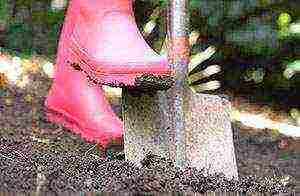 A good owner begins to prepare the carrot beds from the autumn days. Carrot beds should be made where cereals, cucumbers, beets, cabbage or corn used to grow. For a full harvest, only very well-loosened soil is suitable. If the soil is light, not compacted, then you can just walk with a rake or, better, a flat cutter. In other cases, you should seriously tackle loosening, otherwise you will have to harvest crooked, small carrots.
A good owner begins to prepare the carrot beds from the autumn days. Carrot beds should be made where cereals, cucumbers, beets, cabbage or corn used to grow. For a full harvest, only very well-loosened soil is suitable. If the soil is light, not compacted, then you can just walk with a rake or, better, a flat cutter. In other cases, you should seriously tackle loosening, otherwise you will have to harvest crooked, small carrots.
To achieve a bed with light and lush soil, the soil is mixed with compost, peat or sand. You can add manure, but it must be well rotted. Carrots do not like fresh manure and will respond to its introduction with thick and dense tops, fruits with thick peels, unpleasant taste, small and ugly shapes.
Since this vegetable does not tolerate acidic soils, it is worth adding ash, dolomite flour or lime. It would be wise to add various fertilizers right in the fall. In the spring, such a bed should be thoroughly loosened again and only after that sow the seeds.
Planting carrots by seeds in open ground
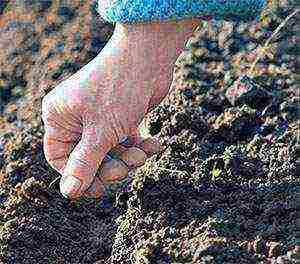 Some summer residents plant seeds simply in the ground, however, it is much better to put carrot seeds soaked for 3 to 4 days, and then dry them a little. This will allow you to identify non-viable seeds and significantly speed up the germination process. Experienced gardeners know how to plant carrots with seeds in the open field.But, since the seeds are very small and it is difficult to plant them, the gardeners have come up with some ways to ensure that the small seeds lie flat and do not all fall into one place.
Some summer residents plant seeds simply in the ground, however, it is much better to put carrot seeds soaked for 3 to 4 days, and then dry them a little. This will allow you to identify non-viable seeds and significantly speed up the germination process. Experienced gardeners know how to plant carrots with seeds in the open field.But, since the seeds are very small and it is difficult to plant them, the gardeners have come up with some ways to ensure that the small seeds lie flat and do not all fall into one place.
Planting carrots in open ground with seeds is as follows:
- most often the seeds are mixed with sand, they do not stick together and fall more evenly into the rows;
- on a roll of toilet paper, each seed is glued to the desired distance with paste; in the spring, such tapes are simply dripped into the garden;
- jelly is prepared from potato starch, seeds are placed in it and poured through the spout of the teapot into the prepared rows;
- if the carrot seeds are pelleted, they are simply sown into the grooves.
In any case, the seeds are planted at a distance of 3 - 5 cm from each other in rows, and between the rows (grooves) themselves, a distance of 15 - 20 cm should be maintained.
 So that the weeds do not crush the tender seedlings, and the moisture does not erode and a crust does not appear on the soil, the crops are covered with foil. Seedlings appear at a temperature of 18 degrees in two weeks. Moreover, young shoots are not afraid of short-term frosts, but after a long cold, the plant stops growing the root and gives out flowering.
So that the weeds do not crush the tender seedlings, and the moisture does not erode and a crust does not appear on the soil, the crops are covered with foil. Seedlings appear at a temperature of 18 degrees in two weeks. Moreover, young shoots are not afraid of short-term frosts, but after a long cold, the plant stops growing the root and gives out flowering.
Outdoor carrot care and proper watering of carrot beds
 Growing carrots and care in the open field requires a certain systematicity. This is especially true for watering. It is very important to know how to water your carrots outdoors. Indeed, with a lack of watering, young roots may not get to the water, and the seedlings will die, and the overflow threatens to turn tasty and juicy carrots into livestock feed. Watering should be done abundantly, but not often. When the carrots already form long roots, some gardeners stop watering them altogether. In this case, the roots rush straight down, forming straight and long roots.
Growing carrots and care in the open field requires a certain systematicity. This is especially true for watering. It is very important to know how to water your carrots outdoors. Indeed, with a lack of watering, young roots may not get to the water, and the seedlings will die, and the overflow threatens to turn tasty and juicy carrots into livestock feed. Watering should be done abundantly, but not often. When the carrots already form long roots, some gardeners stop watering them altogether. In this case, the roots rush straight down, forming straight and long roots.
Frequent, shallow watering promotes hairy growth of the carrots and the fact that the fruit grows crooked. But weaning the plant from watering is also risky. If the carrots are on water starvation for a long time, and then suddenly a rainy period comes, all the fruits will crack. Watering carrots in the open field should not be frequent, but systematic. Already from the moment of the first shoots, carrots can be fed, she will gratefully accept this.
In addition to watering, thinning is necessary. When planting, small seeds sometimes fall so close to each other that they do not allow the fruit to develop fully. If we neglect thinning, the carrots will grow thin, frail, which will quickly rot during storage, and they will not be suitable for the table.
It is recommended to thin out the carrots at 12 and 22 days from germination.
Taking care of carrots in the open field contains another very important stage - loosening. As described above, carrots without this procedure grow crooked, small and ugly. Loosening is often combined with weeding or thinning. Weeding is also needed so that strong weeds do not shade the shoots.
Disease and pest control
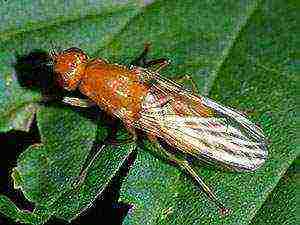 One of the pests of the vegetable is the carrot fly. In order to get rid of it, it is better to arrange the beds in advance in a windy place, the fly does not like winds. It is very advisable to plant carrots next to onions. And so that she does not even look at the carrot bed, it is better to sprinkle the bed with hot pepper, gold or tobacco dust, and mulch with cut grass or straw.
One of the pests of the vegetable is the carrot fly. In order to get rid of it, it is better to arrange the beds in advance in a windy place, the fly does not like winds. It is very advisable to plant carrots next to onions. And so that she does not even look at the carrot bed, it is better to sprinkle the bed with hot pepper, gold or tobacco dust, and mulch with cut grass or straw.
 Timely thinning and loosening helps from carrot rot. Another pest is the mole. To combat this bully, shops offer a variety of tools. It will take a lot of time and effort to properly care for carrots in the open field, however, a luxurious harvest is worth it.
Timely thinning and loosening helps from carrot rot. Another pest is the mole. To combat this bully, shops offer a variety of tools. It will take a lot of time and effort to properly care for carrots in the open field, however, a luxurious harvest is worth it.
Video "Carrot care from A to Z"
Most gardeners necessarily grow on their site. carrot... This juicy orange root vegetable is included in the recipe for most liquid hot dishes (soup, borscht, fish soup, pickle soup, kharcho soup), and is also added to salads and pilaf.To get a bountiful harvest when cultivating carrots, a number of rules must be followed.
Crop rotation
Carrots are not demanding on their predecessors, but, like most crops, they are very fertilizer responsive... Therefore, it is best to plant it in areas of the garden where cucumbers, tomatoes, onions, leafy greens, legumes, all types of cabbage were grown in the previous season - crops for which large doses of organic matter and mineral fertilizers are applied.
It is not recommended to apply fresh manure of farm animals directly under carrots. In the previous place, carrots are planted no earlier than 3-4 years later. This is due to the accumulation of pathogens of crop diseases and their pests (carrot fly and wireworm larvae) in the soil.
Preparing the soil for carrot beds
The largest crop yield is obtained on loose loamy and sandy soilssaturated with humus, with good air permeability. It is desirable to maintain the acidity of the soil at 5.5-7 pH. It is this indicator of acidity that guarantees not only a good harvest, but also the qualitative characteristics of root crops - keeping quality and resistance to various diseases.
On virgin lands, it is possible to obtain good yields of carrots in the first year. To do this, during the autumn digging, it is necessary to carefully remove all the rhizomes of weeds, especially wheatgrass, and also manually select the larvae of the wireworm (click beetle) and the May beetle.
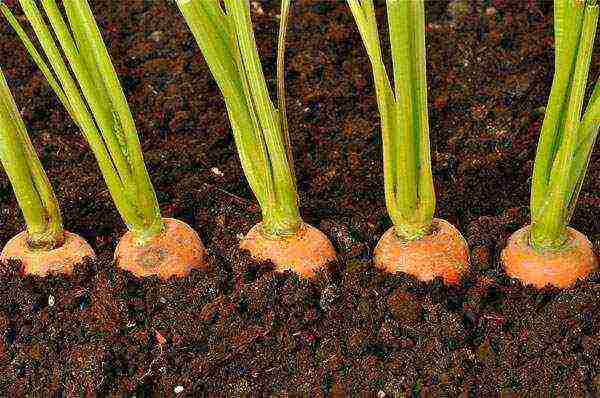
Plot for carrots choose well-lit, even or slightly sloped. Lack of lighting, especially at the beginning of the growing season, negatively affects yields. The land in the beds should be fertile, loose, saturated with nutrients, cultivated, free from weeds and parasitic organisms. High-quality loosening and removal of all kinds of small pebbles are requiredthat can interfere with the normal growth of the root crop inward.
When planting carrots in places close to the surface of groundwater, the beds must be made high (at least 35 cm in height), since excess moisture in the ground provokes the onset and development of diseases of the root system (all kinds of rot).
It is advisable to prepare the beds for planting carrots in the fall, be sure to dig up the ground to a depth of 25 cm with a seam turnover. If the soil on the site is of medium weight, then digging is carried out together with sawdust and peat at the rate of 3 kg of their mixture per square meter. meter.
With increased acidity of the soil in the fall, measures are taken to alkalinization, bringing in a glass of chalk, dolomite flour, dry plaster or lime "fluff" for each square. meter. Wood ash can also be used as a deoxidizer. Ash application rate - 2 glasses / sq. meter. Dosages may fluctuate based on baseline acidity. In small areas, it is possible to use crushed eggshells. It should be slightly warmed up in a frying pan, broken by hand and scattered in thin even layers on the beds.
Fertilizers for carrots
Depending on the activities carried out in the fall, the composition and fertility of the land, in the spring they bring to the beds:
- certain doses of organic matter,
- sand,
- peat,
- mineral fertilizers.
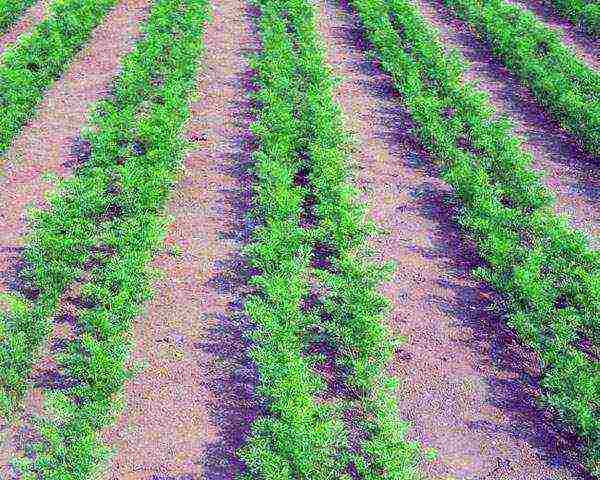
Fertilization in spring, taking into account the type of soil
On sandy soils plant ash, garden compost or humus are applied in the spring, because if fertilizers are embedded in the soil in the fall, then most of them will go into the depths along with melt water. For each meter of the garden bed, 2 buckets of peat or sod land are covered, half a bucket of humus (compost). From mineral fertilizers, it is desirable to use a tablespoon of Agricola-4 / sq. meter.
Peat soils dug up with the addition of half a bucket of river sand (coarse-grained), 4 kg of humus or ready-made compost, a bucket of sod land. Of mineral fertilizers, it is advisable to apply for each square meter. garden meter:
- superphosphate or potassium sulfate (1 tablespoon),
- urea or sodium nitrate (1 tsp),
- potassium chloride (1 tablespoon)
In clay and podzolic soils add a bucket of sand, 4 kg of peat and humus for each square. meter. Of the mineral fertilizers, the most valuable for such soils are superphosphate and nitrophoska (1 tbsp. Spoon / square meter).
Into light loamy soils fertilizers are applied according to the same scheme as on clay, but without the addition of sand.
In fertile chernozem soils of fertilizers, only superphosphate powder should be added (2 tablespoons / square meter).
After digging the soil with fertilizers to a depth of at least 25-30 cm (shovel bayonet), the earth is loosened, leveled and carefully compacted. A few days before sowing carrots in open ground, it is advisable to cover the garden bed with a dense cellophane film to prevent evaporation of valuable moisture and additional heating of the earth.

Sowing carrots
The crop yield is directly influenced by the planting timing and the correct sowing. Since root seeds germinate slowly, they constantly need moisture. Seeds that are not planted on time may simply not sprout. The best results are obtained early sowing of carrots in soil saturated with spring moisture.
For central and central Russia, early carrot varieties are usually planted at the end of April, and mid-ripening varieties - until May 5, but the dates may be shifted taking into account the weather conditions of the current spring. In the southern regions, sowing is carried out already in mid-March, and in mid-June, summer sowing of crops is carried out. See the exact sowing day according to the lunar calendar.
Furrows should be made 2.5 cm deep.It is advisable to leave the distance between rows at least 18-20 cm.Before sowing, the soil is abundantly moistened with water or spilled with an average pink solution of potassium permanganate (for additional soil disinfection), seeds are laid, sprinkled, slightly compacted the ground, slapping it with your palm, and watering the garden bed.
Planting care
Carrot gardening consists in:
- timely feeding,
- watering,
- removing weeds,
- loosening,
- mandatory thinning of plantings, which is carried out twice.
When the appearance the main plant pest - carrot fly, measures are needed to destroy the pest.
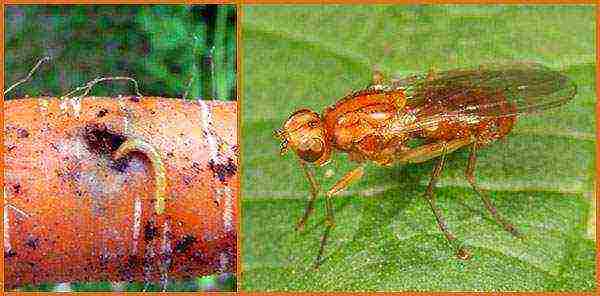
Watering, weeding and loosening
Regular watering is essential... When the first shoots appear, watering is carried out as carefully as possible, trying not to moisten the greens. It is undesirable to allow the soil to dry out on carrot beds, especially during the period of growth in the size of root crops.
With a lack of moisture in the ground, by the middle of summer, carrots may stop growing, and root crops may bend and become coarse. It is noticed that when irrigation is resumed after a drought, the roots begin to crack and in the future are no longer subject to long-term storage.
After each watering, it is imperative to loosen planting to a depth of 6 cm and removing all weeds. Weed grass not only reduces the supply of nutrients to root crops, but also serves as an additional source of nutrition for the main pest of carrots - the carrot fly.
When the tops of the plant reaches a height of 15 cm, it is advisable to mulch the planting.
Fertilizing carrots during the growing season (feeding)
Increase yields are promoted by root feeding... A solution of slurry, bird droppings, urine of farm animals, to which a tablespoon of superphosphate is added to a bucket of composition, is used during the period of active growth of the aerial part of carrots and the formation of root crops (late May-mid-July).
- The first feeding is usually carried out in the phase of 4 leaves, 23-25 days after mass germination, using nitrogen compounds, for example, a urea solution (25 grams per standard bucket of water).
- The second feeding is done 3.5 weeks after the first. Carrots react well to complex mineral dressings, for example, nitroammofoska (30 ml per bucket of water).
One and a half to two months after sowing, the stage of thickening of root crops begins. During this period, the introduction of wood ash is desirable. To do this, the beds are watered, sifted ash is scattered on top, loosening and another watering are carried out.
To increase the sugar content and keeping quality of root crops, seasoned gardeners 20-25 days before harvesting feed the plants with potassium sulfate (35 grams per bucket of water).

Thinning plantings
Thinning of crops is necessary to increase the area of optimal nutrition for each plant and reduce the likelihood of damage to plantings by carrot fly, which activates at the end of May and populates in thickened plantings. The distance between the shoots after thinning in the phase of 2 leaves is left at least 1.5 cm.
The second thinning is done 22-24 days after the first, leaving the strongest plants at a distance of about 5 cm between them. To avoid attracting a dangerous pest - a carrot fly during thinning, before the event, it is necessary to spray the tops with an infusion of bitter red or black pepper (2 teaspoons (with a slide) of ground spices are diluted in a bucket of water, you do not need to insist, the composition is enough for 10 square meters of the garden ).
Carrot fly control measures
Insect larvae harm root crops at all stages of development. They tolerate frost well, so they hibernate in the soil without any problems. There are well-established folk ways to combat the pest.
Garlic and onion, thanks to the secreted phytoncides, scare away the carrot fly, reducing the likelihood of its spread on carrot beds. That is why it is practiced to grow carrots and garlic and carrots and onions together in the same garden. Plants do not interfere with the development of each other and are mutually beneficial - the greens of the carrots scares off the onion fly, which is dangerous for onion plantings. It is also advisable to plant onions and garlic around the perimeter of carrot plantings.
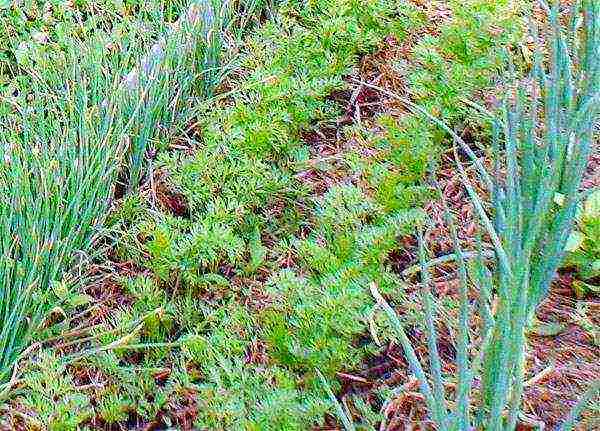
Tobacco dust and mustard powder against the carrot fly. During the egg-laying period (late spring), the carrot beds are pollinated with tobacco dust or mustard powder, sprinkling the earth with a thin layer.
In the summer of carrot flies, infusions for spraying plantings are effective.
1. Coniferous extract. 200 ml of coniferous extract is added to a bucket of water and the beds are treated at the end of May. The treatment is repeated once a week.
2. Infusion of onions and garlic. 200 g of onions together with the husk are crushed, poured in 2 liters of warm clean water and infused for 24 hours. The filtered concentrate is poured into a sprayer, 8 liters of water are added and used to process plantings. To improve adhesion, 40 g of grated household soap (72%) or liquid green soap is introduced into the composition.
3. Decoction of tomato tops. Possesses insecticidal properties and destroys insects. 4 kg of finely chopped leaves and stems of tomatoes are poured with boiling water in an enamel bucket (10 l) and boiled over low heat, covered with a lid, for about half an hour. Filter the cooled broth, add liquid soap (50 g) and dilute with water 1: 3. The plantings are processed at the first signs of a pest invasion.
Harvesting
Dig up the roots carefully, trying not to damage them, since carrots with mechanical damage cannot be saved for a long time. To do this, when digging, they capture the largest layer of earth, turn it over and only then remove the root crop from it.
Get a high-quality and plentiful harvest of carrots even a novice amateur gardener can do it. It is enough to give your plants your love, pay attention to them and follow the recommendations of experienced agronomists. Good harvests to all!

Read related articles
.
Since ancient times, mankind has been engaged in agriculture. Today, all types of vegetables and fruits can be bought in the store without any problems. But no store-bought product can compare to one grown on a backyard. It is much more pleasant to realize that the fruits are grown by our own hands, so much time and effort has been invested in them.And if it also brings benefits, then it is doubly pleasant. One of these vegetable crops growing in the country is carrots.

Carrots are a common crop for growing in the country.
No summer cottage season is complete without planting carrots. Carrots are grown in the open field. Experienced gardeners are confident that the root crop will delight the eye as a result of proper planting and proper care, and they know exactly how to grow large and long carrots, and even sweet ones. They always have a couple of secrets in store.
Summer residents have to work hard: choose the right place, prepare the land, plant and take care of it in a timely manner in order to get a good harvest by autumn. But any spring suffering begins with the selection of seeds.
Seed selection
Modern counters of any stores, including summer cottages, are full of a variety of goods, in which it is not surprising to get confused. Therefore, before you go shopping for seeds, decide why you will plant a root crop:
- for its use in the summer-autumn period;
- for winter storage.
In the first case, the vegetable must be used immediately, since it is not stored for a long time at home. The Vitamin-6 variety is perfect for this application. Varieties that can be stored until the onset of cold weather should have a long growing season. This view can be used for blanks. To preserve the harvest in the winter, you should choose varieties such as:
- Queen of Autumn (sweet and sour taste of carrots);
- Golden autumn;
- Moscow winter.

The queen of autumn is an attractive variety of carrots
Preparing the beds for planting
Every seasoned summer resident has secrets in stock, thanks to which they know how to grow a good harvest of carrots. The preparation of the beds can be done either in the fall or directly in the spring a couple of weeks before sowing.
The first step is to decide on the location. Remember that the vegetable loves well-sunlit areas. Before planting, remember what grew in your garden last year. This is an important factor affecting the harvest. It's good if they used to grow here: cucumbers, potatoes, tomatoes, onions, garlic or cabbage. After dill, parsley, parsnips, planting carrots is not worth it - the root crop will not be born.
Before sowing, the soil is cleared of various kinds of weeds. Professionals believe that it will not be superfluous to re-dig the beds in the spring, this ensures better soil breathability.
Be sure to enrich the soil with a carrot fertilizer. It is recommended to use the following composition for this: 2 tbsp. potassium sulfate, 4 tablespoons granulated superphosphate, some ash and dolomite flour. The mixture of ingredients is applied per square meter of land. The soil for sowing is ready.
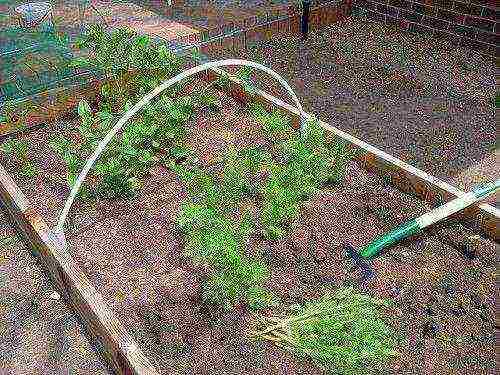
Carrots do not tolerate the neighborhood of weeds
Cooking seeds
Carrot seeds, like any other, need preparation before sowing in open ground. Thanks to this approach, seed germination will be much better. Every seasoned gardener has his own way in the bins, which is easy to use at home. Let's consider the most interesting ones:
- Use for the treatment of growth stimulants. All actions are carried out in accordance with the instructions strictly attached to the chemicals. The process itself takes no more than 20 hours, and the germination capacity exceeds all expectations.
- Sowing seeds into the soil. A cloth bag is taken, grains are put there and all this is buried 15 cm into the ground. The contents must be kept so for at least 10 days, after which they are taken out of the ground.
- Soaking seeds for a day. A rag, cotton wool or toilet paper is taken and thoroughly moistened, it is necessary to keep them in this state only for a day, after which you can start planting.
- Heat treatment with boiling water. Boil water, put the seeds in a rag bag and immerse in boiling water for 20 minutes. Cool the contents of the bag with cold water.
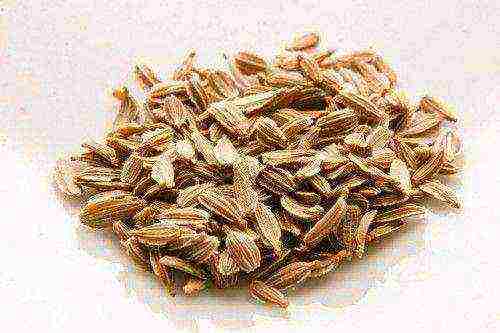
Carrot seeds can be treated with commercially available growth promoters
Planting carrots in the ground
It would seem that the technology of growing carrots in the country is extremely simple, there is no secret here. But is it really so? There are a lot of schemes used for sowing vegetable crops. Everyone chooses the one that is more convenient. Among the sowing methods, the following should be highlighted:
- in bulk;
- rows;
- grooves.
Now more about how to grow carrot seeds.
Growing carrots in bulk is troublesome, but most gardeners believe that the method is the most effective and efficient.
In addition, it is the fastest of all the presented ones. The grains of the vegetable are scattered over the entire surface of the garden bed, pressing lightly on them. After watering, the plants can be covered with foil. Despite all the attractiveness of the process, it has a number of negative aspects:
- some of the seeds remain on the surface of the soil and there will be no seedlings from them;
- seedlings in places are either scarce or too dense;
- after germination, the crop is difficult to weed.
This method of planting a vegetable can leave you without a crop at all, since the young growth can be clogged with fast-growing weeds.
The second method - sowing in rows - is more effective and common among summer residents. The harvest is richer. The root crop is planted in the ground, observing a distance that varies from 7 to 10 cm. But there is also a minus here. The seeds are washed out when it rains and in the place where they were planted, they may not be found.

Sowing in rows is the most popular method among vegetable growers.
Sowing with grooves is a more economical process. If the suburban area is small, then the method is just for you. First of all, outline a garden bed at your dacha. It should be narrow but rather high. Furrows are made on the surface of the soil, departing from the edges by 15 cm, fertilizer for the carrots is selected and placed and watering is performed. Vegetable seeds are sown in them.
The first weeding is done after the shoots appear, that is, approximately in the month of June, about two weeks after the root crop has been planted. The next weed control is carried out after 20-30 days.
Is it possible to plant carrots with seedlings
Quite a lot is known about how to grow carrots in the open field. Is it possible to plant a vegetable through seedlings? Yes. Some varieties are sown in a sheltered place - in a greenhouse or greenhouse. Most people tend to assume that the culture does not tolerate transplanting well. This leads to damage to the ponytails, as a result, it grows ugly. In fact, this is not the case. The seedlings take root well and the yield is excellent. The main thing is not to forget to use fertilizer for carrots.
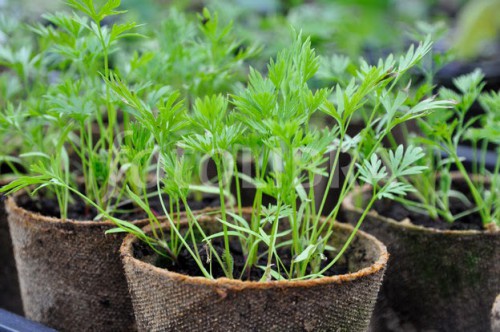
Carrot seedlings take root well and give a high yield
Vegetable crop care
Often summer residents ask themselves the question: how to grow good carrots? She, like other plants, requires attention and timely care, which includes: weeding and feeding, watering and loosening. Watering she needs moderate, but it should be regular throughout the growth. Humidification occurs on an increasing scale. By July, the watering rate is gradually increasing. Per square meter of soil with root crops will go within 20 liters. The closer autumn is, the more the irrigation rate will decline. The region and weather conditions must be taken into account, in accordance with which the corresponding adjustments are demolished.
The second important point when growing a vegetable is feeding carrots. It should be done regularly. How to feed carrots? Each summer resident applies his own fertilizer for carrots. It can be organic matter or one of the types of mineral fertilizers, or both can be used together. Fertilizers for carrots are very different. It won't hurt the culture.
The first time the carrots are fed 10 days after the first shoots appear on the surface.To prepare fertilizer for carrots, you will need: potassium sulfate (1 tablespoon), double superphosphate (1.5 tablespoons). The rate is diluted with 10 liters of water.
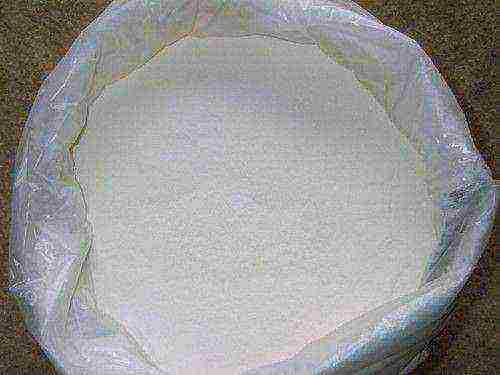
Potassium sulfate activates the growth of carrots
Subsequent feeding occurs two weeks after the first. Fertilizer for carrots is done as follows: in 10 liters of water, it is necessary to dilute potassium sulfate and azofoska (1 tablespoon each).
You should not dwell on any one type of fertilizer, carrot care requires complex measures, therefore, in addition to mineral supplements for feeding, be sure to use organic matter. As a fertilizer for carrots, you can use bird droppings, which are diluted in water and watered with the composition the distance between the rows.
Watering with salt also has a beneficial effect on seedlings, it is necessary to dilute 1 tbsp. in 10 liters of water and water the plants.
Yeast feeding recipe
Such a saying is often heard that it grows by leaps and bounds. Everything is correct and as applicable as fertilizer for carrots. Yeast is a kind of vegetable fertilizer. For this purpose, both dry and "live" yeast are used.
First recipe. In 5 liters of water, 1 kg of "live" yeast is diluted. The resulting concentrate is once again diluted with water (1:10) before watering.
Second recipe. For 10 liters of water, 10 g of dry yeast is taken, 2 tbsp. granulated sugar. Let it brew for 2 hours, after which the composition is again diluted with water (1: 5).
Despite the intensity of growth after such feeding, you should not get carried away with yeast. No more than 3 waterings are carried out per season.
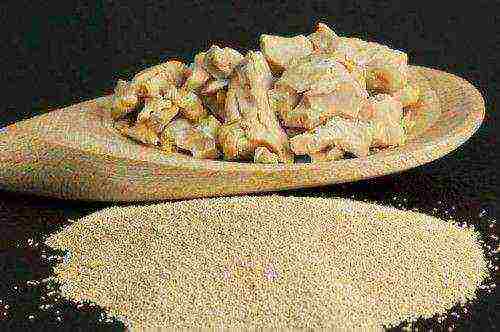
Carrot yeast feed can be made from live or dry yeast
Root pests and diseases
Carrot care includes not only feeding with chemicals and yeast, but also fighting various pests. The main pests for the crop are aphids and carrot flies. They appear when the soil is excessively wet or when there is no proper maintenance. To combat it, seedlings are sprayed with Bitoxibacillin or Lepidocide once every two weeks. The chemicals are effective against insects.
Fungus can develop in high humidity. Here drugs such as Phytocid, Liposam and Mikosan-V will come to the rescue.
Thus, in order to get a good harvest of sweet and juicy root crops in your personal plot, you will have to work hard, that is, not only plant, but also choose the right fertilizer for carrots.
Subscribe Be aware of new products on our site


